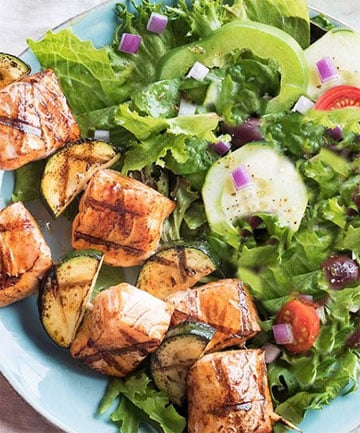According to Zembroski, the DASH diet was developed to treat high blood pressure without medication. It follows the U.S. guidelines for sodium content. "The DASH eating plan consists of vegetables, fruits, lean meats, whole grains, fish and poultry, nuts and beans."
Pros: "It consistently ranks as top one or two diets by US News and World Report," Davis notes. "It's a sustainable program of eating healthy foods with evidence-based results in lowering blood pressure, cholesterol and weight."
Cons: The only con here is that, like with F-Factor, there isn't as much structure, so it may be hard for some people to stick with if they're not regimented or aren't working with a registered dietitian.
Image via @thedietitianist
Pros: "It consistently ranks as top one or two diets by US News and World Report," Davis notes. "It's a sustainable program of eating healthy foods with evidence-based results in lowering blood pressure, cholesterol and weight."
Cons: The only con here is that, like with F-Factor, there isn't as much structure, so it may be hard for some people to stick with if they're not regimented or aren't working with a registered dietitian.
Image via @thedietitianist
The South Beach Diet is a low-carb, high-protein, low-sugar plan that focuses on the glycemic index — how certain foods elevate blood sugar.
Pros: "As with all diets that promote eliminating simple and refined carbs, including baked goods and sugary soft drinks, a benefit is weight loss," Zembroski says. "It also increases the awareness people have on the effects of adding specific carbohydrates into their diets, allowing the identification of which foods and their quantities create cravings and it helps with sugar cravings based on the plan's different phases."
Cons: "There's no cut-off on calorie intake and without understanding an individual's metabolic rate, overconsuming calories sets the stage for increased body fat," Zembroski says. He also notes that it allows for the consumption of a large dose of dairy, including up to two full cups of milk or yogurt, and all the low-fat cheese needed to satisfy hunger, which can cause inflammation and is linked to chronic health issues.
Image via @southbeachdiet
Pros: "As with all diets that promote eliminating simple and refined carbs, including baked goods and sugary soft drinks, a benefit is weight loss," Zembroski says. "It also increases the awareness people have on the effects of adding specific carbohydrates into their diets, allowing the identification of which foods and their quantities create cravings and it helps with sugar cravings based on the plan's different phases."
Cons: "There's no cut-off on calorie intake and without understanding an individual's metabolic rate, overconsuming calories sets the stage for increased body fat," Zembroski says. He also notes that it allows for the consumption of a large dose of dairy, including up to two full cups of milk or yogurt, and all the low-fat cheese needed to satisfy hunger, which can cause inflammation and is linked to chronic health issues.
Image via @southbeachdiet
This diet eliminates all processed foods, refined sugars, grains, legumes and limits fruit for 30 days. If at any point you eat something you're not supposed to, you have to start the 30-day reset over.
Pros: "It's great to use as an elimination diet and getting yourself to consume foods in their natural state," Davis says.
Cons: "It's restrictive — even just for 30 days — making it hard to eat at a majority of restaurants, so dieters must do a lot of home cooking and prep to be successful," Davis says. "It also eliminates foods like whole grains, legumes and limits fruit."
Image via @whole30
Pros: "It's great to use as an elimination diet and getting yourself to consume foods in their natural state," Davis says.
Cons: "It's restrictive — even just for 30 days — making it hard to eat at a majority of restaurants, so dieters must do a lot of home cooking and prep to be successful," Davis says. "It also eliminates foods like whole grains, legumes and limits fruit."
Image via @whole30
"What you can eat is based on points: the amount of food and their respective points are based on unspecific parameters including age, weight, height and gender," Zembroski explains.
Pros: "High-sugar and unhealthful foods have high points value, while healthful foods, including fruits and vegetables, have no points," Zembroski says.
Cons: "You can eat anything you want on Weight Watchers as long as you account for it. This is a major issue as people may eat their points from nutrient-absent processed foods that increase the risk of developing blood-sugar issues, systemic inflammation and disease, as long as the points are accounted for," Zembroski says. He also notes that Weight Watchers bars and smoothies are loaded with processed and unhealthful ingredients, including high-fructose corn syrup, milk, soy protein isolate, artificial sweeteners, flavors and colors.
Image via @weightwatchers
Pros: "High-sugar and unhealthful foods have high points value, while healthful foods, including fruits and vegetables, have no points," Zembroski says.
Cons: "You can eat anything you want on Weight Watchers as long as you account for it. This is a major issue as people may eat their points from nutrient-absent processed foods that increase the risk of developing blood-sugar issues, systemic inflammation and disease, as long as the points are accounted for," Zembroski says. He also notes that Weight Watchers bars and smoothies are loaded with processed and unhealthful ingredients, including high-fructose corn syrup, milk, soy protein isolate, artificial sweeteners, flavors and colors.
Image via @weightwatchers







